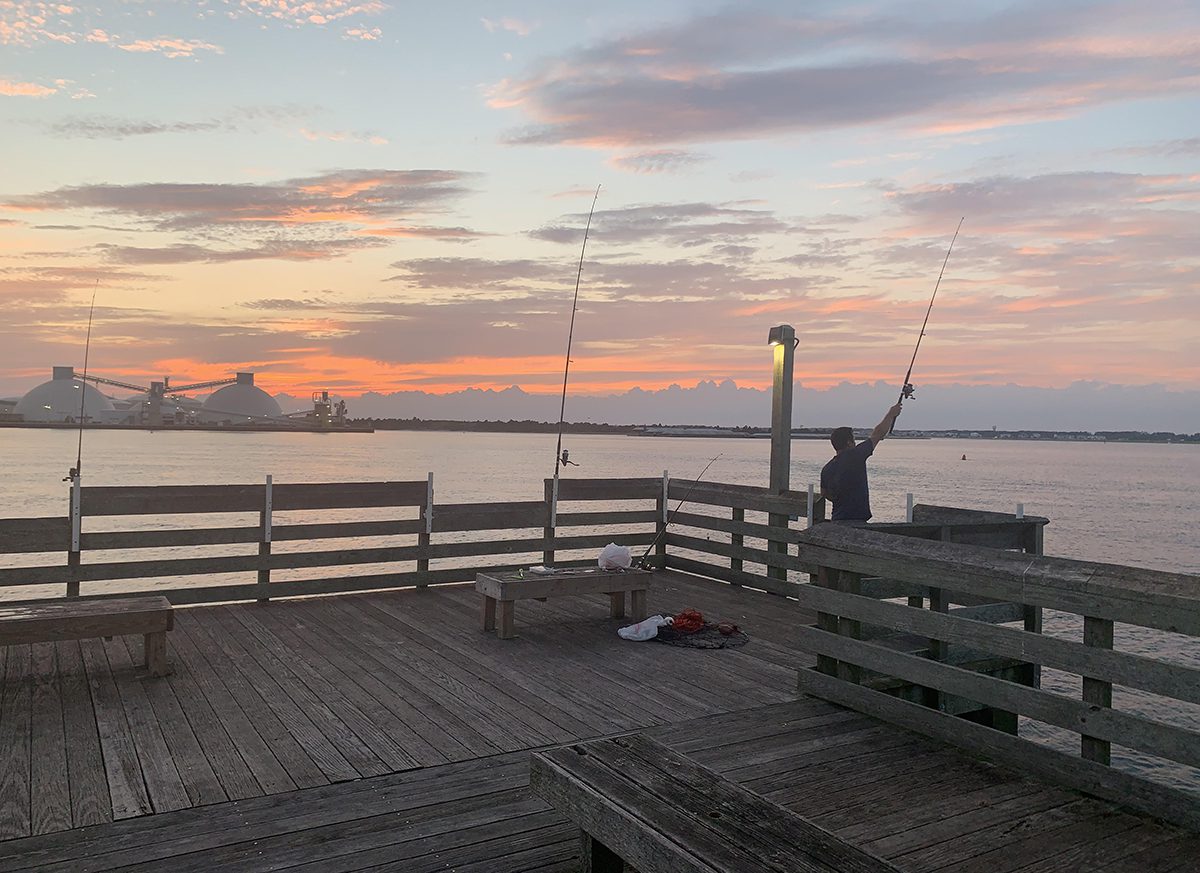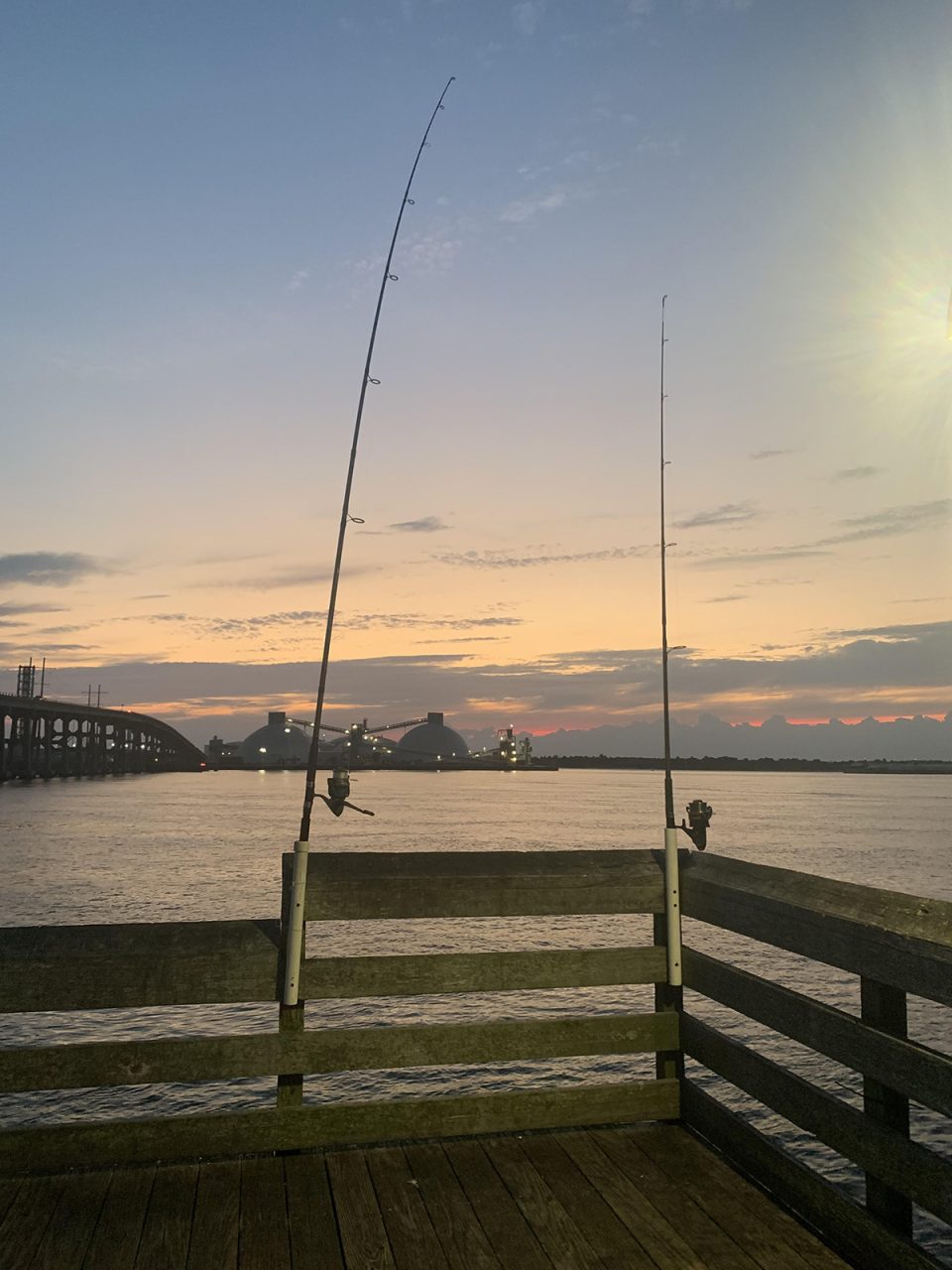
A little past 7 p.m. on a mid-September evening in Beaufort, North Carolina, pink clouds stretch across the sky and reflect in the water, surrounding the Newport River Pier as the sun fades. Scattered along the pier in clusters, are nine people who intermittently cast baited fishing hooks into the water.
It’s a beautiful night for fishing.
Supporter Spotlight
When asked why they fish, many people will say that fishing is a relaxing pastime and that they often throw back what they catch.
Aside from those who engage in recreational, commercial and sport fishing, there is a, seemingly, more elusive type of fisher — one who engages in subsistence fishing, also known as fishing for food.
In an effort to learn more about these subsistence fishers, a group of Duke University researchers developed a research study that examines subsistence fishing. The study defines people who engage in subsistence fishing as having the following characteristics: they rely on fish to survive, have limited income, live close to the source, use basic gear to fish, and eat or sell fish to meet their needs.
In 2020, there were more than 20,000 — the number includes inland and coastal waivers — North Carolinians who received a subsistence fishing waiver, which allowed them to fish for free in North Carolina waterways, according data supplied by the Department of Environmental Quality.

An annual coastal fishing license for an adult resident is $16, and a joint inland/coastal fishing license is $41, according to data supplied by DEQ.
Supporter Spotlight
Fishing waivers can be an important resource for individuals who rely on fishing to put food on the table for their household, extended family or community members. This is also important because the Dietary Guidelines for Americans, 2020-2025, encourages people to consume fish regularly because it provides omega-3 fatty acids, which are an essential part of a healthy diet.
Currently, in North Carolina, and across the country, there is a push to highlight the links between food, nutrition and health. Given that fish is high in omega-3s, for instance, makes it an ideal food to promote in this way.

A two-rod setup
Roy and Benny, stationed near the end of the pier, are friends who fish together regularly. They work for the same company that makes doors for walk-in coolers, they said. Benny appears subdued, content with letting Roy answer the questions about fishing.
Panning the scene on the bridge, one thing immediately stands out: most people are fishing with two rods.
One rod is for catching any number of fish that might be biting, such as red drum, croaker, puffer fish, or mackerel, to name a few, the men explain. The second rod, in most cases, is used to catch “cut bait,” such as lizard fish, Roy said.
When he’s not casting his rod from a pier, Roy said he and his wife like to get out on the water.
“(My wife and I) fish in our kayaks three times a week, and I usually fish with (Benny) on Fridays,” said Roy. He lives on the other side of the Newport River and fishes behind his house about two times a week.
Roy started fishing when he was around 5 years old, and said that his family once “owned the only tackle shop in town.”
While Roy did not say that he and his family depend on what they catch to feed themselves, he did say that his weekly fishing allows him to stock the freezer, which provides the family with a constant source of fish throughout the winter.
“I’ll keep them if they’re worth keeping, but I’m not one of those ones who is actively looking to keep fish,” he said. “I can go catch all the fish I want, so for me, I want something that is worth catching … It gives you an adrenaline rush more than anything.”
Minimizing cost
Nine o’clock rolls around and there are three guys bank fishing along the river, a few miles from the pier. One of them, James, is perched on a 5-gallon bucket, patiently waiting for a tug on his line. He is hoping artificial bait will entice Spanish mackerel to bite.
The area where James and two other men are fishing is dimly lit by light coming from a bridge located a few hundred yards away.
He says that Spanish mackerel will hang around as long as the water temperature is somewhere between 75 and 80 degrees. But once the temperature drops below that sweet spot, they’ll be gone for the season.
“If I can catch 15 Spanish (mackerel) that are over 12 inches, that’s an awesome day,” James said.
James travels regularly from his home in Guilford County to the Beaufort/Morehead City area to fish. During the coronavirus pandemic, he said he left his delivery job because someone threatened him with a gun. Now, he’s trying to earn a living selling the saltwater fish he catches to customers back home. While James fishes to earn a living, he can’t afford a commercial fishing license, a large boat and all the gear that comes with the job.
He says that for a beginning fisher or someone with limited means, purchasing the essential gear to get started does not have to be expensive.
“You can take a $10 rod and come out here and catch more fish than anybody,” he said. “I got a 3-foot rod in the back of my truck, and that rod has almost caught as many fish as any rod that I have … I bought that rod from Walmart for about $15 or $16.”
One aspect of fishing that can be expensive is buying bait. For that reason, James often uses artificial bait that he said can prove to be less expensive in the long run. However, he said that you don’t need to buy bait of any kind to be successful.
“All you need to fish is to catch one fish and you cut it up and throw it back out there (as bait) and you’ll get another one.”
Healthy diet, cause for concern
Fish has long been considered an important part of a healthy diet, but seafood consumption only received the nod from the experts recently in the federal Dietary Guidelines for Americans. In 2005, the guidelines, produced every few years by the U.S. Department of Agriculture, recommended for the first time that people should eat 8 ounces of seafood per week, according to Jessica Soldavini, a UNC Gillings School of Global Public Health professor.
Yet, there are warnings that come with fish consumption. Mercury and other contaminants can be passed from fish to humans. The Food and Drug Administration, or FDA, has a resource guide titled “Advice About Eating Fish” that offers suggestions for how much and what type of fish pregnant women and children should consume.
Additionally, the North Carolina Department of Health and Human Services includes fish consumption advisories for North Carolina on their website.
“Individuals are encouraged to check this database to see if they should limit or avoid consuming fish caught in certain bodies of water,” Soldavini said.
Some fish that are considered safe to consume for pregnant women and children are Atlantic mackerel, tilapia, catfish and whiting, for instance.
Soldavini also said that there are other affordable proteins to consider such as beans, lentils and eggs.
“Individuals may choose not to consume fish for a variety of reasons,” she said. “Other sources of omega-3 fatty acids include plant oils such as canola, flaxseed, and soybean oil and nuts and seeds like walnuts, flaxseed, and chia seeds.”

It’s a spectrum
Around 8:30 a.m. after meeting Roy, Benny and James, Daryl Mouring is the only one fishing on the pier. Mouring lives in Raleigh where he says he fishes everyday in one of the area’s freshwater sources. But once a year for the past 30 years, Mouring has made the trip from Raleigh down to Beaufort to spend time throwing his hook into the salt water.
He said he’s accustomed to catching a variety of fish during his trips to Beaufort, such as “sheepshead, black drum, croakers and puffer fish.”
But in recent years, he says, he’s noticed a change when he travels down from Raleigh to fish on the pier.
“Ten years ago you could fill your cooler in about an hour.” This is no longer the case, he said, and he blames the change on overfishing.
That doesn’t seem to be a problem for Mouring today. This morning he’s been on the pier for about an hour and has already caught a few. Another tug on his line reveals a puffer fish, which offers little resistance as Mouring reels it in.
As a child growing up in Washington, D.C., Mouring was taught to fish by his father –and the only fish he eats is what he catches.
“If you’re on a limited income you can’t pay (the high) price for a piece of fish,” he said. “It ain’t in your budget, it’s not worth it. I’ll look at the fish (in the store) and wish I was down here catching them.”
Aside from providing an affordable source of food, Mourning said he enjoys fishing because he likes spending time in nature and, occasionally, spending time chatting with fellow fishers.
Grant Murray is an associate professor of marine policy at Duke University and was an advisor for the “Fishing for Food” research program. When discussing the research the team did for the project, he agreed that the fishers they interviewed in the Beaufort area didn’t necessarily fit the narrow definition of a subsistence fisher, but represented a range.
“There were a few who were eating all the fish that they caught (and) depending on it daily, either for food or for income,” he said, “all the way down to people who were much more occasional in their fishing, but would give fish to family members, friends or relatives. That was a common story.”
He said he expected to hear more about subsistence fishing, but Murray said he was surprised by some of the reasons given by people who participated in the study for why they fished that extended beyond filling the need for an affordable protein source.
“A lot of other things people talked about as benefits were camaraderie, the mental health, the social activity, the being outside, the exercise, the sense of giving to others when they’re able to share fish,” he said. “There are people out there that are out there for different reasons, different mixes of reason and (varying) dependencies on the protein.”
This is fourth in a series examining the role and sustainability of seafood in a healthy diet and is published in collaboration with North Carolina Health News.








